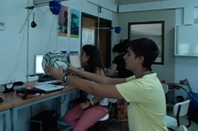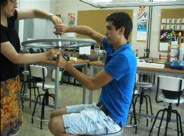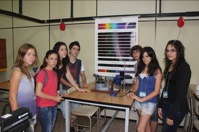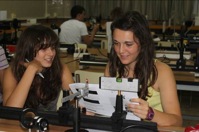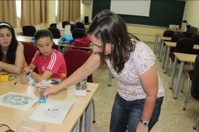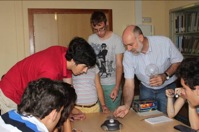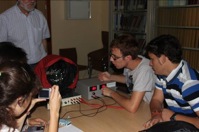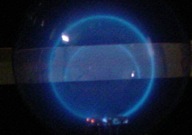The idea of “Un viaje fantástico con los pies en la física” appears from the experience of our Work Group within the development of different initiatives addressed to secondary education students. The project poses to guide young participants through new Physical phenomena and experiments, with a proposal that highlights their fascinating character and their importance and actuality, and where the experimentation and quantification made by the students prevail. For these reasons, a sequence where the promotion of comprehension of what is presented will be followed, including explanations adapted to their academic level and encouraging relations between other sciences and the technology that surrounds us.
The Campus takes place during the month of July and every week participate four groups, composed by 7 or 8 student of of the last course of secondary education or the first course of higher education. The first day starts with the welcoming session and the general explanation of the Campus (every Monday) and the las day (Friday evening) each group realises a short presentation of the obtained results and an analysis of their participation experience in the Campus. Besides these common sessions for all the projects of the VLC-Campus, each students group realises four specific sessions of their project that take place from Tuesday to Friday from 9:00 to 13:30 and one cross-cutting session with all the Campus participants.
The project “Un viaje fantástico con los pies en la física” (An mazing journey down to Physics) is developed at the Faculty of Physics of the Universitat de València and at the Design School of Engineering of the Universitat Politècnica de València, and it is structured in the following sessions:
- Session 1: Can we measure the gravity acceleration on the Tatooine planet? And its density? What is the weightlessness? How is it possible to turn a spaceship or a satellite?
The objective of this session is to get the student used to the different movement types of bodies and the relationship these movements have with the forces acting on them, with an special emphasis on the gravitational force. In addition, the ubiquity of this force in the universe and also the general character of some principles present in every physical phenomenon, allow knowing how things work in very far places (from our solar system to the most distant galaxies).
- Session 2: What actually happens (and I don’t see) when I play the guitar. Standing waves. An echo in my room: the speed at my voice travels. Two go in and one goes out: Sounds interference.
In this session the wave phenomena are introduced through surprising proofs and evidences, starting with those generated by elastic deformations (waves on strings and rings) and acoustic overpressures (sound), because these are more easily perceptible through senses and, therefore, its physic interpretation is more comprehensible.
- Session 3: Dark and light strips. Why do I see a rainbow in Cds? Lighting up objects to unravel its microscopic structure, diffraction and red blood cells? Neon tubes light colours. Measuring the colour (wavelenght) of the laser light.
In this session students can check that the interferences and the diffraction are phenomena that manifest the light wave character and that allow to obtain information of the objects structure that produce them.
- Session 4: Compasses divert, cables move. I move a magnet and I turn the light on. The current: the great unknown. Control where do electrons circulate: a cyclotron at home. The double life of the electron: is it like a particle or like a wave?
The objective of this session is to know phenomena where electrons are involved in different context and natural phenomena, and under the shape of diverse physical behaviours from which several applications are obtained.
In these sessions it is used the laboratory material of the Physics Room Experimenta, as well as additional mechanic material, optical arrays with lenses, lasers and different apertures for interference and diffraction practices (sessions 1 and 3), the experiment suitcases of the “Practices Wardrobe” (sessions 2 and 4) and different demonstrations and computer simulations developed by teachers of the Design School of Engineering of the Universitat Politècnica de València (session 2). This material is complemented with the “Colection of experiment demonstrations of the Faculty of Physics of the Universitat de València.
All the sessions include introductory explanations by the teaching staff (from the university and the secondary education) where, with the help of the mentioned materials, it is favoured the concepts comprehension and its relation with the natural phenomena and the technological applications.
During the sessions, it is promoted the participation of the students encouraging them to participate actively in the demonstrations and to realise the measuring of the different experiments. Students work experimentally by pairs, manipulating the instruments and realising the proposed measures for each case, being helped every moment by the teaching staff. In order to facilitate their work at the laboratory, they are provided with explanatory guides of the experiments and worksheets where they annotate the realised work. Down below, are shown some photos of the different sessions realised at the Physics Room Experimenta and other laboratories of the Faculty of Physics of the Universitat de València during the Campus of the academic year 2011-12.


